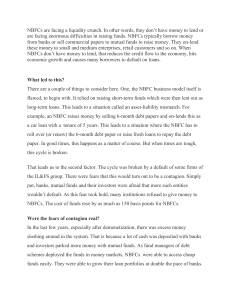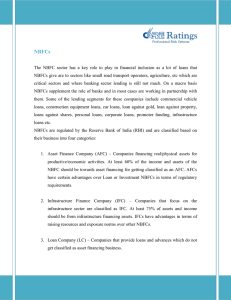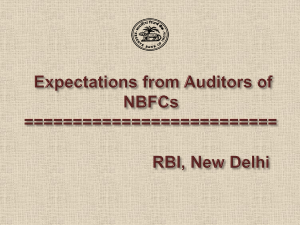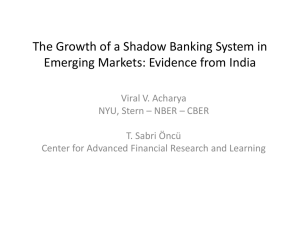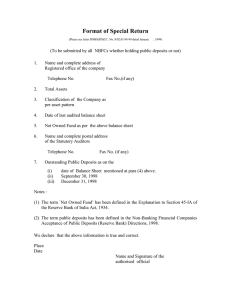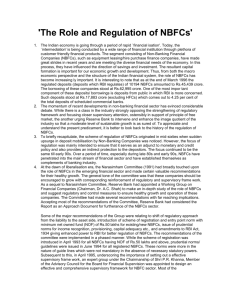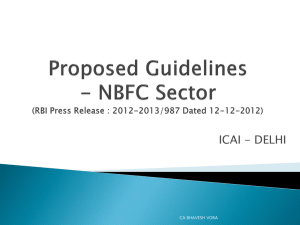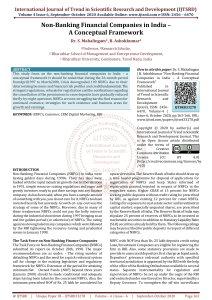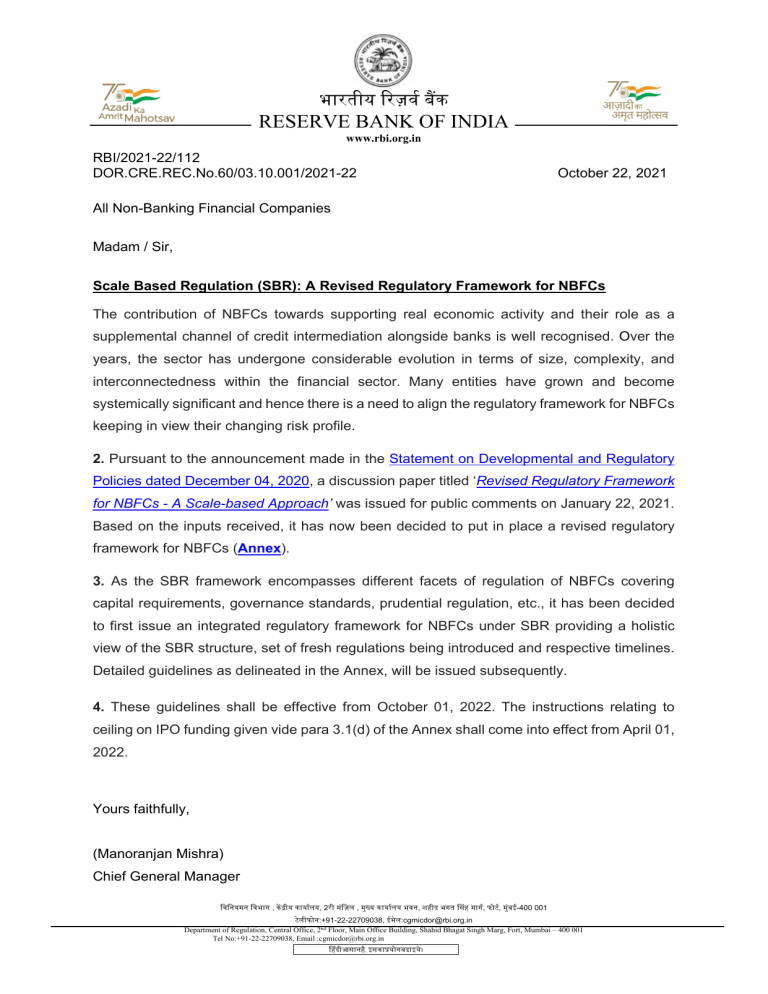
भारतीय �रज़वर् ब�क RESERVE BANK OF INDIA www.rbi.org.in RBI/2021-22/112 DOR.CRE.REC.No.60/03.10.001/2021-22 October 22, 2021 All Non-Banking Financial Companies Madam / Sir, Scale Based Regulation (SBR): A Revised Regulatory Framework for NBFCs The contribution of NBFCs towards supporting real economic activity and their role as a supplemental channel of credit intermediation alongside banks is well recognised. Over the years, the sector has undergone considerable evolution in terms of size, complexity, and interconnectedness within the financial sector. Many entities have grown and become systemically significant and hence there is a need to align the regulatory framework for NBFCs keeping in view their changing risk profile. 2. Pursuant to the announcement made in the Statement on Developmental and Regulatory Policies dated December 04, 2020, a discussion paper titled ‘Revised Regulatory Framework for NBFCs - A Scale-based Approach’ was issued for public comments on January 22, 2021. Based on the inputs received, it has now been decided to put in place a revised regulatory framework for NBFCs (Annex). 3. As the SBR framework encompasses different facets of regulation of NBFCs covering capital requirements, governance standards, prudential regulation, etc., it has been decided to first issue an integrated regulatory framework for NBFCs under SBR providing a holistic view of the SBR structure, set of fresh regulations being introduced and respective timelines. Detailed guidelines as delineated in the Annex, will be issued subsequently. 4. These guidelines shall be effective from October 01, 2022. The instructions relating to ceiling on IPO funding given vide para 3.1(d) of the Annex shall come into effect from April 01, 2022. Yours faithfully, (Manoranjan Mishra) Chief General Manager िविनयमन िवभाग , क� �ीय कायार्लय, 2री मंिज़ल , मुख्य कायार्लय भवन, शहीद भगत �संह मागर्, फोटर्, मुंबई-400 001 टेलीफोन:+91-22-22709038, ईमेल:cgmicdor@rbi.org.in Department of Regulation, Central Office, 2nd Floor, Main Office Building, Shahid Bhagat Singh Marg, Fort, Mumbai – 400 001 Tel No:+91-22-22709038, Email :cgmicdor@rbi.org.in �हंदीआसानहै, इसका�योगबढाइये। Annex Framework for Scale Based Regulation for Non-Banking Financial Companies Section I 1. REGULATORY STRUCTURE FOR NBFCS 1.1 Regulatory structure for NBFCs shall comprise of four layers based on their size, activity, and perceived riskiness. NBFCs in the lowest layer shall be known as NBFC - Base Layer (NBFC-BL). NBFCs in middle layer and upper layer shall be known as NBFC - Middle Layer (NBFC-ML) and NBFC - Upper Layer (NBFC-UL) respectively. The Top Layer is ideally expected to be empty and will be known as NBFC - Top Layer (NBFC-TL). Details of NBFCs populating the various layers shall be as prescribed in paras 1.2 to 1.6 below: Base Layer 1.2 The Base Layer shall comprise of (a) non-deposit taking NBFCs below the asset size of ₹1000 crore and (b) NBFCs undertaking the following activities- (i) NBFC-Peer to Peer Lending Platform (NBFC-P2P), (ii) NBFC-Account Aggregator (NBFC-AA), (iii) Non-Operative Financial Holding Company (NOFHC) and (iv) NBFCs not availing public funds and not having any customer interface 1. Middle Layer 1.3 The Middle Layer shall consist of (a) all deposit taking NBFCs (NBFC-Ds), irrespective of asset size, (b) non-deposit taking NBFCs with asset size of ₹1000 crore and above and (c) NBFCs undertaking the following activities (i) Standalone Primary Dealers (SPDs), (ii) Infrastructure Debt Fund - Non-Banking Financial Companies (IDF-NBFCs), (iii) Core Investment Companies (CICs), (iv) Housing Finance Companies (HFCs) and (v) Infrastructure Finance Companies (NBFC-IFCs). Upper Layer 1.4 The Upper Layer shall comprise of those NBFCs which are specifically identified by the Reserve Bank as warranting enhanced regulatory requirement based on a set of parameters and scoring methodology as provided in the Appendix to this circular. The top ten eligible NBFCs in terms of their asset size shall always reside in the upper layer, irrespective of any other factor. Top Layer 1.5 The Top Layer will ideally remain empty. This layer can get populated if the Reserve Bank is of the opinion that there is a substantial increase in the potential systemic risk from specific NBFCs in the Upper Layer. Such NBFCs shall move to the Top Layer from the Upper Layer. Public Funds and Customer Interface as defined in Master Direction on Non-Banking Financial Company - Systemically Important NonDeposit taking Company and Deposit taking Company (Reserve Bank) Directions, 2016 dated September 01, 2016 1 2 Categorisation of NBFCs carrying out specific activity 1.6 As the regulatory structure envisages scale based as well as activity-based regulation, the following prescriptions shall apply in respect of the NBFCs a) NBFC-P2P, NBFC-AA, NOFHC and NBFCs without public funds and customer interface will always remain in the Base Layer of the regulatory structure. b) NBFC-D, CIC, IFC and HFC will be included in Middle Layer or the Upper Layer (and not in the Base layer), as the case may be. SPD and IDF-NBFC will always remain in the Middle Layer. c) The remaining NBFCs, viz., Investment and Credit Companies (NBFC-ICC), Micro Finance Institution (NBFC-MFI), NBFC-Factors and Mortgage Guarantee Companies (NBFC-MGC) could lie in any of the layers of the regulatory structure depending on the parameters of the scale based regulatory framework. d) Government owned NBFCs shall be placed in the Base Layer or Middle Layer, as the case may be. They will not be placed in the Upper Layer till further notice. Section II 2. SCALE BASED REGULATORY FRAMEWORK 2.1 References to NBFC-ND, NBFC-ND-SI & NBFC-D - From October 01, 2022, all references to NBFC-ND shall mean NBFC-BL and all references to NBFC-D and NBFC-NDSI shall mean NBFC-ML or NBFC-UL, as the case may be 2. 2.2 Progressive application of regulations - Regulatory revisions applicable to lower layers of NBFCs will automatically be applicable to NBFCs residing in higher layers, unless stated otherwise. 2.3 Regulatory guidelines for NBFCs in Base Layer - NBFCs in the Base Layer (NBFC-BL) shall be subject to regulations as currently applicable to NBFC-ND, except for the changes mentioned below at paras 3.1 and 3.2. NBFC-P2P, NBFC-AA, and NOFHC shall be subject to extant regulations governing them 3. 2.4 Regulatory guidelines for NBFCs in Middle Layer - NBFCs in the Middle Layer (NBFCML) shall continue to follow regulations as currently applicable for NBFC-ND-SIs, NBFC-Ds, CICs, SPDs and HFCs, as the case may be, except for the changes mentioned below at paras 3.1 and 3.2. It is clarified that existing NBFC-ND-SIs having asset size of ₹500 crore and above but below ₹1000 crore (except those necessarily featuring in Middle Layer) will be known as NBFC-BL. 3 Master Directions - Non-Banking Financial Company – Peer to Peer Lending Platform (Reserve Bank) Directions, 2017; Master Direction- Non-Banking Financial Company - Account Aggregator (Reserve Bank) Directions, 2016; and Guidelines for Licensing of New Banks in the Private Sector dated February 22, 2013 and other related guidelines containing instructions on NOFHC. 2 3 2.5 Regulatory guidelines for NBFCs in Upper Layer - NBFCs lying in the Upper Layer (NBFC-UL) shall be subject to regulations applicable to NBFC-ML in addition to the changes mentioned below at paras 3.1 and 3.2. 3. REGULATORY CHANGES UNDER SCALE BASED REGULATION (SBR) 3.1 Regulatory changes under SBR for all the layers in the regulatory structure a) Net Owned Fund – Regulatory minimum Net Owned Fund (NOF) for NBFC-ICC, NBFCMFI and NBFC-Factors shall be increased to ₹10 crore. 4 The following glide path is provided for the existing NBFCs to achieve the NOF of ₹10 crore: NBFCs Current NOF By March 31, 2025 By March 31, 2027 NBFC-ICC ₹2 crore ₹5 crore ₹10 crore NBFC-MFI ₹5 crore (₹2 crore in NE Region) ₹7 crore (₹5 crore in NE Region) ₹10 crore ₹5 crore ₹7 crore ₹10 crore NBFC-Factors However, for NBFC-P2P, NBFC-AA, and NBFCs with no public funds and no customer interface, the NOF shall continue to be ₹2 crore. It is clarified that there is no change in the existing regulatory minimum NOF for NBFCs - IDF, IFC, MGCs, HFC, and SPD. 5 b) NPA Classification - The extant NPA classification norm stands changed to the overdue period of more than 90 days for all categories of NBFCs. A glide path is provided to NBFCs in Base Layer to adhere to the 90 days NPA norm as under – NPA Norms Timeline >150 days overdue By March 31, 2024 >120 days overdue By March 31, 2025 > 90 days By March 31, 2026 Explanation: The glide path will not be applicable to NBFCs which are already required to follow the 90-day NPA norm. c) Experience of the Board - Considering the need for professional experience in managing the affairs of NBFCs, at least one of the directors shall have relevant experience of having worked in a bank/ NBFC. d) Ceiling on IPO Funding – There shall be a ceiling of ₹1 crore per borrower for financing subscription to Initial Public Offer (IPO). NBFCs can fix more conservative limits. 3.2 Regulatory changes under SBR for different layers in the regulatory structure – It is clarified that there shall be no distinction in the NOF requirement for NBFCs registered in the North East Region. NOF for different categories are - IDF and IFC - ₹300 crore, MGC- ₹100 crore, HFCs- ₹20 crore, SPDs which undertake only the core activities - ₹150 crore, SPDs which also undertake non-core activities -₹250 crore. 4 5 4 3.2.1 Capital Guidelines – Regulatory changes under SBR applicable to NBFC-ML and NBFC-UL a) Internal Capital Adequacy Assessment Process (ICAAP) - NBFCs are required to make a thorough internal assessment of the need for capital, commensurate with the risks in their business. This internal assessment shall be on similar lines as ICAAP prescribed for commercial banks under Pillar 2 (Master Circular – Basel III Capital Regulations dated July 01, 2015). While Pillar 2 capital will not be insisted upon, NBFCs are required to make a realistic assessment of risks. Internal capital assessment shall factor in credit risk, market risk, operational risk and all other residual risks as per methodology to be determined internally. The methodology for internal assessment of capital shall be proportionate to the scale and complexity of operations as per their Board approved policy. The objective of ICAAP is to ensure availability of adequate capital to support all risks in business as also to encourage NBFCs to develop and use better internal risk management techniques for monitoring and managing their risks. This will facilitate an active dialogue between the supervisors and NBFCs on the assessment of risks and monitoring as well as mitigation of the same. Additional regulatory changes under SBR applicable to NBFC-UL b) Common Equity Tier 1 – In order to enhance the quality of regulatory capital, NBFC-UL shall maintain Common Equity Tier 1 capital of at least 9 per cent of Risk Weighted Assets. c) Leverage - In addition to the CRAR, NBFC-UL will also be subjected to leverage requirement to ensure that their growth is supported by adequate capital, among other factors. A suitable ceiling for leverage will be prescribed subsequently for these entities as and when necessary. d) Differential standard asset provisioning- NBFC-UL shall be required to hold differential provisioning towards different classes of standard assets. A detailed circular will be issued by the Bank for guidelines at paras b, c, and d above. 3.2.2 Prudential Guidelines – Regulatory changes under SBR applicable to NBFC-ML and NBFC-UL a) Concentration of credit/ investment - The extant credit concentration limits prescribed for NBFCs separately for lending and investments shall be merged into a single exposure limit of 25% for single borrower/ party and 40% for single group of borrowers/ parties. Further, the concentration limits shall be determined with reference to the NBFC’s Tier 1 capital instead of their Owned Fund. The revised norms are indicated in the table below: 5 Existing limit Revised limit (as a percentage of Owned Fund) (as a percentage of Tier I Capital) Lending Investment Total borrower/ 15 15 25 Single borrower/ party 25 Single group of borrowers/ parties 25 25 40 Single group of borrowers/ parties 40 Single party Exposure NBFC-UL shall follow these norms till Large Exposure Framework is put in place for them. Extant instructions on concentration norms for different categories of NBFC, other than the changes indicated above, will continue to remain applicable. b) Sensitive Sector Exposure (SSE) - Exposure to capital market (direct and indirect) and commercial real estate 6 shall be reckoned as sensitive exposure for NBFCs. NBFCs shall fix Board-approved internal limits for SSE separately for capital market and commercial real estate exposures. Dynamic vulnerability assessments of various sectors and their likely impact on business, as evaluated periodically, should help NBFCs determine such internal exposure limits. While the Board is free to determine various sub-limits within the overall SSE internal limits, the following are specifically prescribed: i) A sub-limit within the commercial real estate exposure ceiling shall be fixed internally for financing land acquisition. ii) Ceiling on IPO Funding as mentioned at Para 3.1. Housing Finance Companies shall continue to follow specific regulation on sensitive sector exposure, as are currently applicable in terms of paragraph 22 7 & 23 8 of Master Direction – Non-Banking Financial Company – Housing Finance Company (Reserve Bank) Directions, 2021. c) Regulatory restrictions on loans – NBFCs shall be subject to regulatory restrictions in respect of the following: i) Granting loans and advances to directors, their relatives and to entities where directors or their relatives have major shareholding. ii) Granting loans and advances to Senior Officers of the NBFC. iii) While appraising loan proposals involving real estate, NBFCs shall ensure that the borrowers have obtained prior permission from government / local governments / Sensitive Sector Exposure as enumerated in para 3.6, Annex XIV of Master Direction on Non-Banking Financial Company Systemically Important Non-Deposit taking Company and Deposit taking Company (Reserve Bank) Directions, 2016 dated September 01, 2016 7 No housing finance company shall invest in land or buildings, except for its own use, an amount exceeding twenty per cent of its capital fund. 8 The aggregate exposure of a housing finance company to the capital market in all forms (both fund based, and non-fund based) should not exceed 40 per cent of its net worth as on March 31 of the previous year. 6 6 other statutory authorities for the project, wherever required. To ensure that the loan approval process is not hampered on account of this, while the proposals could be sanctioned in normal course, the disbursements shall be made only after the borrower has obtained requisite clearances from the government authorities. A detailed circular on the areas mentioned at para c above will be issued by the Reserve Bank in due course. In the meantime, extant norms shall prevail. Additional regulatory changes under SBR applicable to NBFC-UL d) Large Exposure Framework – It has been decided to introduce Large Exposure Framework (LEF) for NBFCs placed in the Upper Layer. Accordingly, large exposure of an NBFC to all counterparties and groups of connected counterparties will be considered for exposure ceilings. Simplified and separate guidelines will be issued incorporating the definition of large exposure, regulatory reporting and large exposure limits. e) Internal Exposure Limits - In addition to the internal limits on SSE in respect of capital market and commercial real estate as indicated in para b) above, Board of NBFC-UL shall also determine internal exposure limits on other important sectors to which credit is extended. Further, NBFC-UL shall put in place an internal Board approved limit for exposure to the NBFC sector. 3.2.3 Governance Guidelines Regulatory changes under SBR applicable to NBFC-BL a) Risk Management Committee – In order that the Board is able to focus on risk management, NBFCs shall constitute a Risk Management Committee (RMC) either at the Board or executive level. The RMC shall be responsible for evaluating the overall risks faced by the NBFC including liquidity risk and will report to the Board. b) Disclosures - Disclosure requirements shall be expanded, inter alia, to include types of exposure, related party transactions, loans to Directors/ Senior Officers and customer complaints. c) Loans to directors, senior officers and relatives of directors - NBFC-BL shall have a Board approved policy on grant of loans to directors, senior officers and relatives of directors and to entities where directors or their relatives have major shareholding. A detailed circular on paras 3.2.3 (b) & (c) will be issued by the Reserve Bank in due course. 7 Regulatory changes under SBR applicable to NBFC-ML and NBFC-UL d) Key Managerial Personnel - Except for directorship in a subsidiary, Key Managerial Personnel 9 shall not hold any office (including directorships) in any other NBFC-ML or NBFC-UL. A timeline of two years is provided with effect from October 01, 2022 to ensure compliance with these norms. It is clarified that they can assume directorship in NBFCBLs. e) Independent Director – Within the permissible limits in terms of Companies Act, 2013, an independent director shall not be on the Board of more than three NBFCs (NBFC-ML or NBFC-UL) at the same time. Further, the Board of the NBFC shall ensure that there is no conflict arising out of their independent directors being on the Board of another NBFC at the same time. A timeline of two years is provided with effect from October 01, 2022 to ensure compliance with these norms. There shall be no restriction to directorship on the Boards of NBFC-BLs, subject to applicable provisions of Companies Act, 2013. f) Disclosures - NBFCs shall, in addition to the existing regulatory disclosures, disclose the following in their Annual Financial Statements, with effect from March 31, 2023: i) Corporate Governance report containing composition and category of directors, shareholding of non-executive directors, etc. ii) Disclosure on modified opinion, if any, expressed by auditors, its impact on various financial items and views of management on audit qualifications. iii) Items of income and expenditure of exceptional nature. iv) Breaches in terms of covenants in respect of loans availed by the NBFC or debt securities issued by the NBFC including incidence/s of default. v) Divergence in asset classification and provisioning above a certain threshold to be decided by the Reserve Bank. g) Chief Compliance Officer – In order to ensure an effective compliance culture, it is necessary to have an independent compliance function and a strong compliance risk management framework in NBFCs. NBFCs are, therefore, required to appoint a Chief Compliance Officer (CCO), who should be sufficiently senior in the organization hierarchy. NBFCs shall put in place a Board approved policy laying down the role and responsibilities of the CCO with the objective of promoting better compliance culture in the organization. h) Compensation guidelines - In order to address issues arising out of excessive risk taking caused by misaligned compensation packages, it has been decided that NBFCs shall put in place a Board approved compensation policy. The guidelines shall at the minimum include, a) constitution of a Remuneration Committee, b) principles for fixed/ variable pay 9 As defined in Section 2 (51) of Companies Act, 2013, as amended from time to time. 8 structures, and c) malus/ claw back provisions. The Nomination and Remuneration Committee shall ensure that there is no conflict of interest. i) Other Governance matters - NBFCs shall comply with the following: i) The Board shall delineate the role of various committees (Audit Committee, Nomination and Remuneration Committee, Risk Management Committee or any other Committee) and lay down a calendar of reviews. ii) NBFCs shall formulate a whistle blower mechanism for directors and employees to report genuine concerns. iii) The Board shall ensure good corporate governance practices in the subsidiaries of the NBFC. j) Core Banking Solution - NBFCs with 10 and more branches are mandated to adopt Core Banking Solution. A glide path of 3 years with effect from October 01, 2022 is being provided. Detailed circulars will be issued in due course by the Reserve Bank on guidelines indicated at paras f, g, h, i and j above. Additional regulatory changes under SBR applicable to NBFC-UL k) Qualification of Board Members - Board members shall be competent to manage the affairs of the NBFC. The composition of the Board should ensure mix of educational qualification and experience within the Board. Specific expertise of Board members will be a prerequisite depending on the type of business pursued by the NBFC. l) Listing & Disclosures - NBFC-UL shall be mandatorily listed within 3 years of identification as NBFC-UL. Disclosure requirements shall be put in place on the same lines as applicable to a listed company even before the actual listing, as per Board approved policy of the NBFC. m) Removal of Independent Directors – NBFC-UL shall be required to report to the supervisors in case any Independent Director is removed/ resigns before completion of his normal tenure. 3.3 Regulatory guidelines for NBFCs under Top Layer – NBFCs falling in the Top Layer of the regulatory structure shall, inter alia, be subject to higher capital charge. Such higher requirements shall be specifically communicated to the NBFC at the time of its classification in the Top Layer. There will be enhanced and intensive supervisory engagement with these NBFCs. 9 Section III 4. TRANSITION PATH 4.1 Transition Plan - Once a NBFC is identified for inclusion as NBFC-UL, the NBFC shall be advised about its classification by the Department of Regulation, Reserve Bank and it will be placed under regulation applicable to the Upper Layer. For this purpose, the following timelines shall be adhered to: a) Within 3 months of being advised by the RBI regarding its inclusion in the NBFC-UL, the NBFC shall put in place a Board approved policy for adoption of the enhanced regulatory framework and chart out an implementation plan for adhering to the new set of regulations. b) The Board shall ensure that the stipulations prescribed for the NBFC-UL are adhered to within a maximum time-period of 24 months from the date of advice regarding classification as a NBFC-UL from the Reserve Bank. During the period of transition, calibrated increment to business may be allowed through supervisory engagement. The period of 3 months provided for charting out the plan for implementation shall be subsumed within the 24months’ time-period referred to above. c) The roadmap as approved by the Board towards implementation of the enhanced regulatory requirement shall be submitted to the Reserve Bank and shall be subject to supervisory review. 4.2 Transition of NBFCs to the Upper Layer a) Once an NBFC is categorised as NBFC-UL, it shall be subject to enhanced regulatory requirement, at least for a period of five years from its classification in the layer, even in case it does not meet the parametric criteria in the subsequent year/s. In other words, it will be eligible to move out of the enhanced regulatory framework only if it does not meet the criteria for classification for five consecutive years. b) NBFC-UL may however move out of the enhanced regulatory framework before the period of five years if the movement is on account of voluntary strategic move to readjust operations as per a Board approved policy. This stipulation shall not apply if the scaling down of operations is on account of adverse situations specific to the NBFC and its deteriorating financial conditions. c) NBFCs which are close to meeting the parameters and benchmarks that would render them eligible for classification as NBFC-UL shall be intimated about the same to enable them to readjust their operations, in case they intend to continue to function as NBFC-ML on a long-term basis and do not want to graduate to NBFC-UL. 10 4.3 Review of Assessment Methodology - The methodology for assessing the NBFC-UL shall be reviewed periodically. 4.4 Classification of Government owned NBFCs - As per the Reserve Bank’s circular on ‘Withdrawal of Exemptions Granted to Government Owned NBFCs’ dated May 31, 2018, the Government owned NBFCs are still in the transition period to attain the minimum CRAR. It has, therefore, been decided not to subject these NBFCs to the Upper Layer regulatory framework at this juncture. A decision on including eligible Government NBFCs meeting the specified criteria into the Upper Layer will be taken at a later stage and till that time the guidelines as applicable for the NBFC-ML shall apply. 4.5 Regulation of NBFCs not availing public funds and not having customer interface NBFCs not availing public funds and not having customer interface bear a different risk profile and hence deserve a differential regulatory treatment. It has been decided that Reserve Bank will come out with separate regulations for such NBFCs in due course. Till such time, the extant regulations will continue to apply. *** 11 Appendix Scoring Methodology for Identification of NBFC as NBFC-UL Upper Layer shall be populated with NBFCs, identified by way of a parametric scoring methodology, comprising of quantitative and qualitative parameters/ supervisory judgment. The quantitative and qualitative parameters shall have weightage of 70% and 30% respectively. Scoring methodology for identification of an NBFC as NBFC-UL shall be based on the set of NBFCs fulfilling the following criteria: a. Top 50 NBFCs (excluding top ten NBFCs based on asset size, which automatically fall in the Upper Layer) based on their total exposure including credit equivalent of offbalance sheet exposure. b. NBFCs designated as NBFC-UL in the previous year. c. NBFCs added to the set by supervisors using supervisory judgment. The computation of scores of all NBFCs in the above set shall be performed annually based on their position as on March 31 each year. Components of the parametric analysis Parameter Sub-Parameters SubPara Weights 1. Size & Total exposure (on- and off-balance sheet) & Leverage Leverage (total debt to total equity) 15 (i) Intra-financial system assets 10 2. Interconnectedne • Quantitative Parameter (70%) ss 20 + Lending to financial institutions (including undrawn committed lines); • Holdings of securities issued by other financial institutions. • Net mark-to-market reverse repurchase agreements with other financial institutions. • Net mark-to-market OTC derivatives with financial institutions. (ii) Intra-financial system liabilities • Borrowings from financial institutions (including undrawn committed lines) • All marketable securities issued by the finance company to financial institutions; • Net mark-to-market repurchase agreements with other financial institutions; 12 10 Paramet er Weights 35 25 Parameter Sub-Parameters SubPara Weights • Paramet er Weights Net mark-to-market OTC derivatives with financial institutions (iii) Securities outstanding with non-financial 5 institutions (issued by the NBFC) 3. Complexity (i) Notional Amount of Over-the-Counter (OTC) 5 10 Derivatives • OTC derivatives cleared through a central counterparty • OTC derivatives settled bilaterally (ii) Trading and Available-for-Sale Securities 4. Nature and • type of liabilities The amount and type of liabilities, including 5 10 the degree of reliance on short-term funding • Liquid asset ratios, which are intended to indicate a nonbank financial company’s ability to repay its short-term debt. • The ratio of unencumbered and highly liquid Qualitative Parameter / Supervisory inputs (30%) assets to the net cash outflows that a nonbank financial company could encounter in a short-term stress scenario. • Callable debt as a fraction of total debt, which provides one measure of a nonbank financial company’s ability to manage its funding position in response to changes in interest rates. • Asset-backed funding versus other funding, to determine a nonbank financial company’s susceptibility to distress in particular credit markets. • Asset-liability duration and gap analysis, which is intended to indicate how well a nonbank financial company is matching the re-pricing and maturity of the nonbank financial company’s assets and liabilities. • A study on the borrowings split by type i.e. Secured debt securities; subordinated debt securities; preferred shares/CCPS; CPs; unsecured debt; securitisation and any other 13 30 Parameter Sub-Parameters SubPara Weights 5. Group • Total Number of entities Structure • Total number of layers • Total Intra group exposure 6. Segment The importance of the NBFC as a source of credit penetration to a specific segment or area Total Score Paramet er Weights 10 10 100 *** 14
